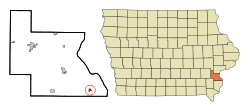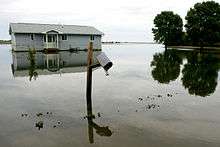Oakville, Iowa
Oakville is a city in Louisa County, Iowa, United States. The population was 173 at the 2010 census. It is part of the Muscatine Micropolitan Statistical Area.
Oakville, Iowa | |
|---|---|
 Location of Oakville, Iowa | |
| Coordinates: 41°5′52″N 91°2′37″W | |
| Country | |
| State | |
| County | Louisa |
| Area | |
| • Total | 0.43 sq mi (1.12 km2) |
| • Land | 0.43 sq mi (1.11 km2) |
| • Water | 0.00 sq mi (0.01 km2) |
| Elevation | 541 ft (165 m) |
| Population | |
| • Total | 173 |
| • Estimate (2019)[3] | 169 |
| • Density | 395.78/sq mi (152.79/km2) |
| Time zone | UTC-6 (Central (CST)) |
| • Summer (DST) | UTC-5 (CDT) |
| ZIP code | 52646 |
| Area code(s) | 319 |
| FIPS code | 19-58395 |
| GNIS feature ID | 0459778 |
History
Oakville was laid out in 1891.[4]
Geography
Oakville is located at 41°5′52″N 91°2′37″W (41.097853, -91.043625).[5]
According to the United States Census Bureau, the city has a total area of 0.43 square miles (1.11 km2), of which 0.42 square miles (1.09 km2) is land and 0.01 square miles (0.03 km2) is water.[6]
Demographics
| Year | Pop. | ±% |
|---|---|---|
| 1910 | 389 | — |
| 1920 | 466 | +19.8% |
| 1930 | 389 | −16.5% |
| 1940 | 391 | +0.5% |
| 1950 | 360 | −7.9% |
| 1960 | 346 | −3.9% |
| 1970 | 369 | +6.6% |
| 1980 | 470 | +27.4% |
| 1990 | 442 | −6.0% |
| 2000 | 439 | −0.7% |
| 2010 | 173 | −60.6% |
| 2019 | 169 | −2.3% |
| Source:"U.S. Census website". United States Census Bureau. Retrieved 2020-03-29. and Iowa Data Center Source: | ||
2010 census
At the 2010 census there were 173 people in 62 households, including 42 families, in the city. The population density was 411.9 inhabitants per square mile (159.0/km2). There were 95 housing units at an average density of 226.2 per square mile (87.3/km2). The racial makup of the city was 97.7% White, 0.6% from other races, and 1.7% from two or more races. Hispanic or Latino of any race were 2.9%.[2]
Of the 62 households 41.9% had children under the age of 18 living with them, 40.3% were married couples living together, 14.5% had a female householder with no husband present, 12.9% had a male householder with no wife present, and 32.3% were non-families. 29.0% of households were one person and 12.9% were one person aged 65 or older. The average household size was 2.79 and the average family size was 3.36.
The median age was 28.3 years. 37% of residents were under the age of 18; 8.6% were between the ages of 18 and 24; 24.9% were from 25 to 44; 20.3% were from 45 to 64; and 9.2% were 65 or older. The gender makeup of the city was 51.4% male and 48.6% female.
2000 census
At the 2000 census there were 439 people in 179 households, including 119 families, in the city. The population density was 1,044.8 people per square mile (403.6/km2). There were 193 housing units at an average density of 459.3 per square mile (177.4/km2). The racial makup of the city was 99.32% White, 0.46% Asian, and 0.23% from two or more races. Hispanic or Latino of any race were 0.91%.[8]
Of the 179 households 33.0% had children under the age of 18 living with them, 49.2% were married couples living together, 12.3% had a female householder with no husband present, and 33.5% were non-families. 28.5% of households were one person and 12.3% were one person aged 65 or older. The average household size was 2.45 and the average family size was 2.97.
The age distribution was 26.9% under the age of 18, 8.0% from 18 to 24, 28.0% from 25 to 44, 22.6% from 45 to 64, and 14.6% 65 or older. The median age was 34 years. For every 100 females, there were 99.5 males. For every 100 females age 18 and over, there were 89.9 males.
The median household income was $29,018 and the median family income was $32,250. Males had a median income of $31,346 versus $21,389 for females. The per capita income for the city was $13,276. About 3.0% of families and 7.7% of the population were below the poverty line, including 8.8% of those under age 18 and 6.1% of those age 65 or over.
June 2008 flooding

Due to the catastrophic statewide major flooding of June 2008, the recovery of the city is under question.[9]
References
- "2019 U.S. Gazetteer Files". United States Census Bureau. Retrieved July 17, 2020.
- "U.S. Census website". United States Census Bureau. Retrieved 2012-05-11.
- "Population and Housing Unit Estimates". United States Census Bureau. May 24, 2020. Retrieved May 27, 2020.
- Springer, Arthur (1912). History of Louisa County, Iowa, from Its Earliest Settlement to 1912, Volume 1. S. J. Clarke Publishing Company. p. 319.
- "US Gazetteer files: 2010, 2000, and 1990". United States Census Bureau. 2011-02-12. Retrieved 2011-04-23.
- "US Gazetteer files 2010". United States Census Bureau. Archived from the original on January 12, 2012. Retrieved 2012-05-11.
- "Census of Population and Housing". Census.gov. Retrieved June 4, 2015.
- "U.S. Census website". United States Census Bureau. Retrieved 2008-01-31.
- NPR.org